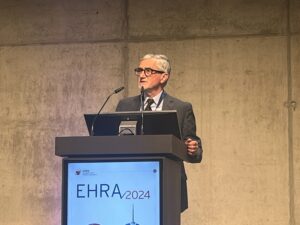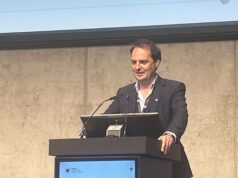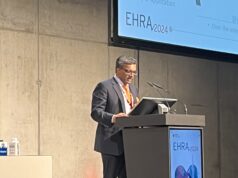
Clinical findings of the B3 study, assessing the impact of closed loop stimulation on the incidence of sub-clinical atrial fibrillation (AF) in sinus node disease patients, have been presented during a late-breaking trial session at the European Heart Rhythm Association (EHRA) 2024 congress (7–9 April, Berlin, Germany).
Ennio Pisanò (Vito Fazzi Hospital, Lecce, Italy) detailed the findings of the study, in which it was shown that in patients with sinus node disease and an indication for dual-chamber pacing, closed loop stimulation reduced the risk of sub-clinical AF and stroke by 16% compared to conventional accelerometer-based pacing.
Closed loop stimulation is a unique rate-adaptive algorithm that is able to detect movement, emotional stress, physical stress, or physical activity.
Results of the study showed that closed loop simulation pacing achieved this reduction delaying the time to first subclinical AF (atrial high rate episodes [AHREs] between >6 minutes and <7 days). Sinus node disease patients with preserved atrioventricular conduction and no history of AF benefitted the most from closed loop stimulation pacing.
“AHREs raise concerns due to their inherent increased thromboembolic and cardiovascular risks and because there is an unclear treatment strategy. The B3 study results brings great news for sinus node disease patients with indication for dual-chamber pacing thanks to closed loop stimulation, a rate-adaptive algorithm that has proven to delay new onset of AHREs, especially those of long duration.” commented Giovanni Luca Botto, a member of the B3 Steering Committee and member of the EHRA Board on the results.
“For the first time, we’ve substantiated the clinical benefits of closed loop stimulation for patients with sinus node disease. The study underscores the necessity of activating closed loop stimulartion atop DDD [dual chamber] pacing, offering pacemaker or ICD patients who require dual-chamber pacing additional protection,” added Pisanò.
The B3 trial enrolled 1,390 patients across 53 centres in Europe and the Asia-Pacific region, with a three-year follow up. It is the first large randomised clinical trial that evaluated the benefits of closed loop stimulation in terms of clinical endpoints such as clinically relevant AF and stroke.
It is estimated that 40% of sinus node disease patients receiving ICD or dual-chamber pacemakers develop asymptomatic sub-clinical AF episodes, which elevates the risk of ischaemic stroke, heart failure, and other cardiac complications.
“The B3 study brings compelling evidence that our unique impedance-based myocardial contractility sensor (CLS), brings additional long-term benefits for cardiac device patients with clear clinical impact: it is the only pacing mode able to delay the onset of AF,” says David Hayes, chief medical officer, Biotronik.












